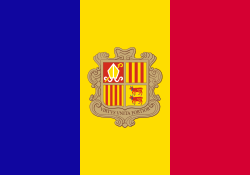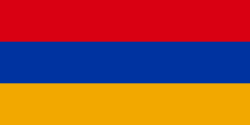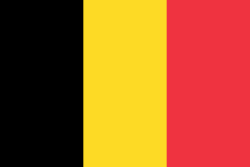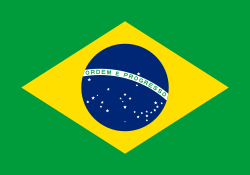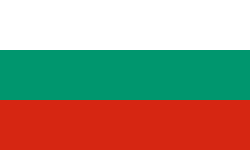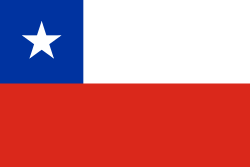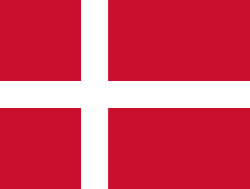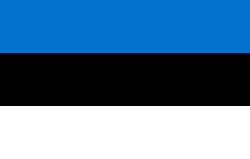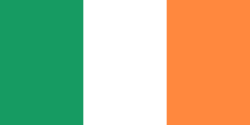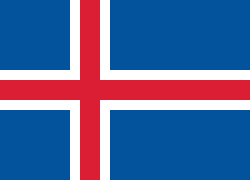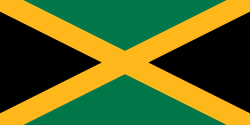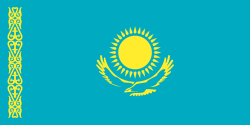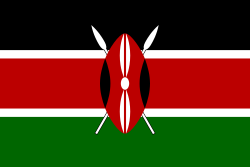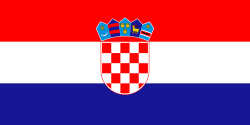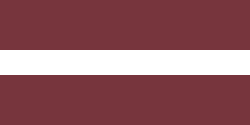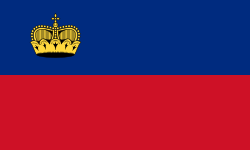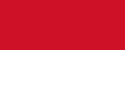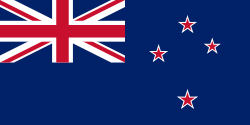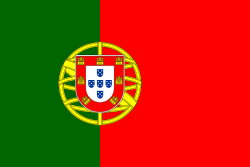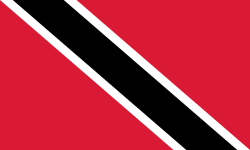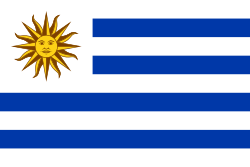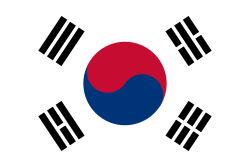Olympiska vinterspelen 1998
| Den här artikeln behöver källhänvisningar för att kunna verifieras. (2014-08) Åtgärda genom att lägga till pålitliga källor (gärna som fotnoter). Uppgifter utan källhänvisning kan ifrågasättas och tas bort utan att det behöver diskuteras på diskussionssidan. |
| Olympiska vinterspelen 1998 | |
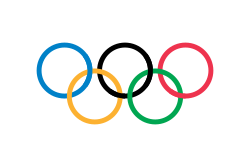 | |
| Grenar | 72 grenar i 15 sporter |
|---|---|
| Deltagare | |
| Nationer | 72 |
| Aktiva | 2 176 |
| Män | 1 389 |
| Kvinnor | 787 |
| Värdskap | |
| Land | |
| Ort | Nagano |
| Arena | Nagano Olympic Stadium |
| Invigning | 7 februari 1998 |
| Spelen öppnades av | Akihito (Japans kejsare) |
| Läste deltagarnas ed | Kenji Ogiwara |
| Läste funktionärernas ed | Junko Hiramatsu |
| Elden tändes av | Midori Ito |
| Avslutning | 22 februari 1998 |
Olympiska vinterspelen 1998 var de artonde (XVIII) olympiska vinterspelen, som hölls i Nagano i Japan. Detta var första gången på 26 år som ett vinterspel hölls i Asien, efter 1972 års spel i Sapporo (även det i Japan).
Spelen fick en del problem, vädret var väldigt varierande, med snö, regn och dimma. Detta gjorde att den alpina skidåkningen fick många problem. Herrarnas störtlopp fick skjutas upp fyra gånger. Under spelens andra vecka fanns det oro att alpina skidåkningen inte skulle hinna slutföras före avslutningsceremonin. Ett av åken i bob fick också förflyttas.
Ett antal nya grenar gjorde debut under spelen, med damernas ishockey i spetsen, som USA vann med en mild skräll över favoriterna Kanada. Snowbord var en OS-sport för första gången med grenarna halfpipe och storslalom. I herrarnas storslalom diskvalificerades vinnande Ross Rebagliati, Kanada, två dagar efter vinsten för att hans dopingtest hade varit positivt för marijuana. Men efter en protest från Kanadas olympiska kommitté fick han behålla guldmedaljen. Curling var för första gången en medalj-sport.
Kandidatur
Andra kandidater var; Aosta, Jaca, Östersund, Salt Lake City. Arrangörsstaden valdes i Birmingham den 15 juni 1991 på IOK:s nittiosjunde kongress. Nagano vann över Salt Lake City med enbart fyra röster. En anledning till valet av Nagano kan ha varit att amerikanska Atlanta hade anordnat olympiska sommarspelen 1996.
| Omröstningsresultat | ||||||
|---|---|---|---|---|---|---|
| Stad | Nation | Rond 1 | Rond 2 | Rond 3 | Rond 4 | Rond 5 |
| Nagano | 21 | - | 30 | 36 | 46 | |
| Salt Lake City | 15 | 59 | 27 | 29 | 42 | |
| Östersund | 18 | - | 25 | 23 | - | |
| Jaca | 19 | - | 5 | - | - | |
| Aosta | 15 | 29 | - | - | - | |
Emblem
Spelens emblem var en blomma, där varje blomblad var en idrottare som utövade en vintersport. Den kan också ses som en symbolisk snöflinga för de olympiska vinterspelen. Blomman kan också associera till en bergsblomma, som markerar Naganos engagemang för miljön. Blomman kallades således för snöblomma.
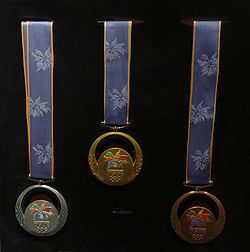
Medaljen
För att förmedla lokala särdrag hade medaljerna skapats i lack (Kiso lack). Dekorationen är en präglad förgyllning (eller Maki-e), med så kallade shippoyaki (dvs. cloisonné-teknik) och metallarbete med stor precision. Framsidan är den uppgående solen i Maki-e, omgiven av olivkvistar och tillsammans med emblemet i cloisonné. De lackerade delarna gjordes individuellt av konstnärer från Kiso-regionen. Medaljerna hade en diameter på 80 mm med en tjocklek på 9,7 mm och guldmedalj vägde 256g, silvermedaljen 250g och bronsmedaljen 230 g.
Noterbart
- Tara Lipinski vann som 15-åring damernas konståkning, och blev den yngsta att ta en individuell medalj i ett olympiskt vinterspel.
- Danmark tog sin första och hittills enda OS-medalj genom att ta ett silver i curling
- USA tog den första guldmedaljen i damernas turnering i ishockey.
- Bjørn Dæhlie, Norge, vann fyra medaljer i längdskidåkning varav tre var guld.
- Snowboard gjorde debut som officiell sport.
- National Hockey League (NHL) gjorde för första gången uppehåll för att spelarna skulle kunna delta i olympiska spelen.
Sporter
Deltagande nationer
 Amerikanska Jungfruöarna (7)
Amerikanska Jungfruöarna (7) Andorra (2)
Andorra (2) Argentina (3)
Argentina (3) Armenien (1)
Armenien (1) Australien (23)
Australien (23) Azerbajdzjan (4)
Azerbajdzjan (4) Belgien (1)
Belgien (1) Bermuda (1)
Bermuda (1) Bosnien och Hercegovina (8)
Bosnien och Hercegovina (8) Brasilien (1)
Brasilien (1) Bulgarien (19)
Bulgarien (19) Chile (3)
Chile (3) Cypern (3)
Cypern (3) Danmark (12)
Danmark (12) Estland (20)
Estland (20) Finland (85)
Finland (85) Frankrike (107)
Frankrike (107) Georgien (4)
Georgien (4) Grekland (6)
Grekland (6) Indien (1)
Indien (1) Iran (1)
Iran (1) Irland (6)
Irland (6) Island (7)
Island (7) Israel (3)
Israel (3) Italien (112)
Italien (112) Jamaica (6)
Jamaica (6) Japan (156)
Japan (156) Jugoslavien (2)
Jugoslavien (2) Kanada (144)
Kanada (144) Kazakstan (60)
Kazakstan (60) Kenya (1)
Kenya (1) Kina (55)
Kina (55) Kinesiska Taipei (7)
Kinesiska Taipei (7) Kroatien (6)
Kroatien (6) Kirgizistan (1)
Kirgizistan (1) Lettland (29)
Lettland (29) Liechtenstein (8)
Liechtenstein (8) Litauen (7)
Litauen (7) Luxemburg (1)
Luxemburg (1) Makedonien (3)
Makedonien (3) Moldavien (2)
Moldavien (2) Monaco (4)
Monaco (4) Mongoliet (1)
Mongoliet (1) Nederländerna (22)
Nederländerna (22) Nordkorea (8)
Nordkorea (8) Norge (76)
Norge (76) Nya Zeeland (8)
Nya Zeeland (8) Polen (39)
Polen (39) Puerto Rico (6)
Puerto Rico (6) Portugal (2)
Portugal (2) Rumänien (16)
Rumänien (16) Ryssland (122)
Ryssland (122) Schweiz (69)
Schweiz (69) Slovenien (34)
Slovenien (34) Slovakien (37)
Slovakien (37) Spanien (13)
Spanien (13) Sydkorea (37)
Sydkorea (37) Storbritannien (34)
Storbritannien (34) Sverige (99)
Sverige (99) Sydafrika (2)
Sydafrika (2) Tjeckien (60)
Tjeckien (60) Turkiet (1)
Turkiet (1) Tyskland (125)
Tyskland (125) Trinidad och Tobago (2)
Trinidad och Tobago (2) Ukraina (56)
Ukraina (56) Ungern (17)
Ungern (17) Uruguay (1)
Uruguay (1) USA (156)
USA (156) Uzbekistan (4)
Uzbekistan (4) Venezuela (1)
Venezuela (1) Belarus (59)
Belarus (59) Österrike (96)
Österrike (96)
Medaljfördelning
Värdnation (Japan)
| Pl. | Nation | Guld | Silver | Brons | Totalt |
|---|---|---|---|---|---|
| 1 | 12 | 9 | 8 | 29 | |
| 2 | 10 | 10 | 5 | 25 | |
| 3 | 9 | 6 | 3 | 18 | |
| 4 | 6 | 5 | 4 | 15 | |
| 5 | 6 | 3 | 4 | 13 | |
| 6 | 5 | 4 | 2 | 11 | |
| 7 | 5 | 1 | 4 | 10 | |
| 8 | 3 | 5 | 9 | 17 | |
| 9 | 3 | 1 | 2 | 6 | |
| 10 | 2 | 6 | 2 | 10 |
Se även
Externa länkar
- Olympiska rörelsen
- Officiell rapport
 Wikimedia Commons har media som rör Olympiska vinterspelen 1998.
Wikimedia Commons har media som rör Olympiska vinterspelen 1998.
Media som används på denna webbplats
Olympic Movement flag
Proportions 2:3, created 1913, adopted 1914, first used 1920.
- Colors as per http://fairspielen.de/wp-content/uploads/2015/09/Annexe-3-Olympism_and_the_Olympic_Symbol_-_Principles_and_Usages_Guide-1.pdf
- blue: PMS 3005C
- yellow: PMS 137C
- black: PMS 426C
- green: PMS 355C
- red: PMS 192C
- Dimensions of the rings taken from http://fairspielen.de/wp-content/uploads/2015/09/Annexe-3-Olympism_and_the_Olympic_Symbol_-_Principles_and_Usages_Guide-1.pdf
Författare/Upphovsman: Tkgd2007, Licens: CC BY-SA 3.0
A new incarnation of Image:Question_book-3.svg, which was uploaded by user AzaToth. This file is available on the English version of Wikipedia under the filename en:Image:Question book-new.svg
Pictograms of Olympic sports - Speed Skating
Pictograms of Olympic sports - Figure skating
The civil ensign and flag of Belgium. It is identical to Image:Flag of Belgium.svg except that it has a 2:3 ratio, instead of 13:15.
Det är enkelt att lägga till en ram runt den här bilden
Flag of Iran. The tricolor flag was introduced in 1906, but after the Islamic Revolution of 1979 the Arabic words 'Allahu akbar' ('God is great'), written in the Kufic script of the Qur'an and repeated 22 times, were added to the red and green strips where they border the white central strip and in the middle is the emblem of Iran (which is a stylized Persian alphabet of the Arabic word Allah ("God")).
The official ISIRI standard (translation at FotW) gives two slightly different methods of construction for the flag: a compass-and-straightedge construction used for File:Flag of Iran (official).svg, and a "simplified" construction sheet with rational numbers used for this file.
Flag of Israel. Shows a Magen David (“Shield of David”) between two stripes. The Shield of David is a traditional Jewish symbol. The stripes symbolize a Jewish prayer shawl (tallit).
Flag of Jamaica. “The sunshine, the land is green, and the people are strong and bold” is the symbolism of the colours of the flag. GOLD represents the natural wealth and beauty of sunlight; GREEN represents hope and agricultural resources; BLACK represents the strength and creativity of the people. The original symbolism, however, was "Hardships there are, but the land is green, and the sun shineth", where BLACK represented the hardships being faced.
Variant version of a flag of Japan, used between January 27, 1870 and August 13, 1999 (aspect ratio 7:10).
Flag of Serbia and Montenegro, was adopted on 27 April 1992, as flag of Federal Republic of Yugoslavia (1992-2003).
Kanadas flagga, införd 1965; denna version med Pantone‐nyanser. Nuvarande utformning ersatte den tidigare kanadensiska Red Ensign.
Chinese Taipei Olympic Flag. According to the official website of Chinese Taipei Olympic Committee, Blue Sky(circle) & White Sun(triangles) above the Olympic rings is neither the National Emblem of the Republic of China, nor the Party Emblem of Kuomintang (KMT), but a design in between, where the triangles do not extend to the edge of the blue circle, as registered at International Olympic Committee in 1981 and digitally rendered in 2013. Besides, the blue outline of the five-petaled plum blossom is broader than the red one. Moreover, the CMYK code of the blue one and the Blue Sky & White Sun is "C100-M100-Y0-K0", and different from the Olympic rings (C100-M25-Y0-K0). Note that it's the only version recognized by IOC.
Det är enkelt att lägga till en ram runt den här bilden
Flag of Liechtenstein
Flag of Portugal, created by Columbano Bordalo Pinheiro (1857–1929), officially adopted by Portuguese government in June 30th 1911 (in use since about November 1910). Color shades matching the RGB values officially reccomended here. (PMS values should be used for direct ink or textile; CMYK for 4-color offset printing on paper; this is an image for screen display, RGB should be used.)
The flag of Slovenia.
- "The construction sheet for the coat of arms and flag of the Republic of Slovenia
- is issued in the Official Gazette Uradni list Republike Slovenije #67, 27 October 1994
- as the addendum to the Law on the coat of arms and flag."
Färg som används: National flag | South African Government and Pantone Color Picker
| grön | rendered as RGB 0 119 73 | Pantone 3415 C |
| gul | rendered as RGB 255 184 28 | Pantone 1235 C |
| röd | rendered as RGB 224 60 49 | Pantone 179 C |
| blå | rendered as RGB 0 20 137 | Pantone Reflex Blue C |
| vit | rendered as RGB 255 255 255 | |
| svart | rendered as RGB 0 0 0 |
Trinidad och Tobagos flagga
Författare/Upphovsman: Thomasbellooficial, Licens: CC BY-SA 4.0
Flag of the Republic of Venezuela 1954-2006.
Flag of Belarus 1995-2012
Författare/Upphovsman: Gutten på Hemsen, Licens: CC0
Flag of Norway with colors from the previous version on Commons. This file is used to discuss the colors of the Norwegian flag.
Pictograms of Olympic sports - Ski jumping
Flag of Georgia used from 1990 to 2004, with slightly different proportions than the 1918 to 1921 flag.
Olympic Rings without "rims" (gaps between the rings), As used, eg. in the logos of the 2008 and 2016 Olympics. The colour scheme applied here was specified in 2023 guidelines.
Pictograms of Olympic sports - Freestyle skiing
Pictograms of Olympic sports - Ice hockey
Pictograms of Olympic sports - Curling
Pictograms of Olympic sports - Bobsleigh
Flag of Belarus 1995-2012
Flag of Serbia and Montenegro, was adopted on 27 April 1992, as flag of Federal Republic of Yugoslavia (1992-2003).
Variant version of a flag of Japan, used between January 27, 1870 and August 13, 1999 (aspect ratio 7:10).
Flag of South Korea from October 1997 to May 2011. In May 2011, the exact colors were specified into their current shades.
Pictograms of Olympic sports - Biathlon
Pictograms of Olympic sports - Snowboarding
Pictograms of Olympic sports - Alpine skiing
Pictograms of Olympic sports - Short track speed skating
Pictograms of Olympic sports - Nordic combined
Pictograms of Olympic sports - Luge
Pictograms of Olympic sports - Cross country skiing
Författare/Upphovsman: Scorpion, Licens: CC BY-SA 3.0
A set of 1998 Winter Olympics medals on display at the Hockey Hall of Fame
1910 Flag of Bermuda (with smaller coat of arms)










